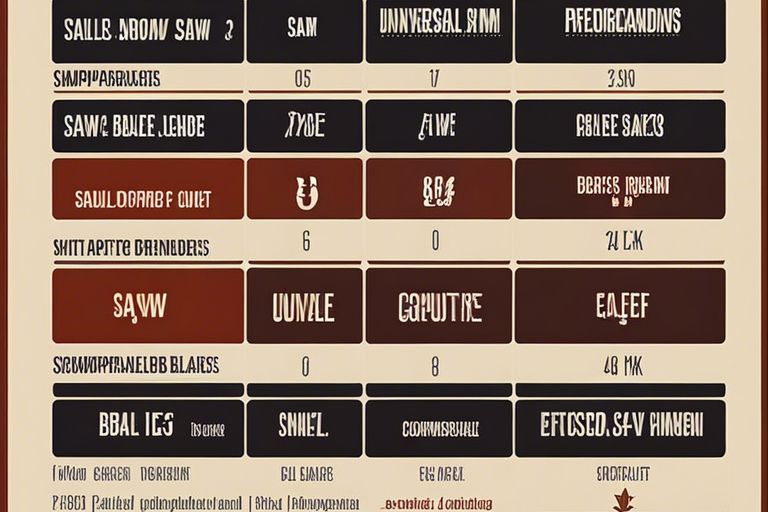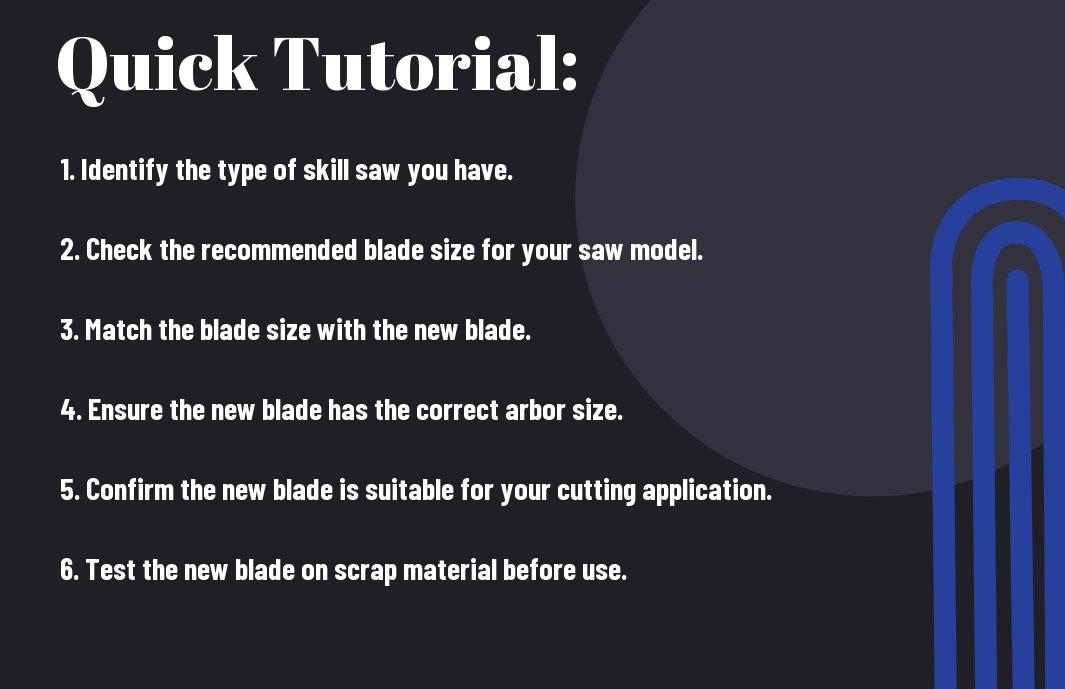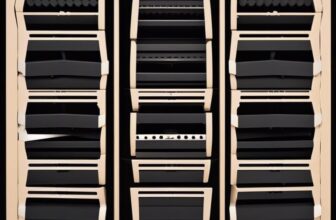Are skill saw blades universal

Did you know that not all skill saw blades are universal? Understanding the compatibility of saw blades with your tool is crucial for efficiency and safety in woodworking projects. In this comprehensive guide, we will explore into the world of skill saw blades, exploring their various types, sizes, and uses to help you make informed decisions for your next cutting task. Stay tuned to learn how to choose the right blade for your skill saw and avoid any costly mistakes.

Key Takeaways:
- Skill saw blades may not be universally compatible: It’s important to check the manufacturer’s specifications to ensure the blade is suitable for your specific tool.
- Consider blade size and arbor size: Match the blade diameter and arbor size with your skill saw to ensure proper fit and performance.
- Choose the right blade for the job: Different blades are designed for specific materials and cutting applications, so select the appropriate blade for optimal results.


Understanding Skill Saw Blade Compatibility
Arbor Size and Shape
There’s crucial information to consider when it comes to skill saw blade compatibility. One of the most important factors is the arbor size and shape. The arbor is the shaft on which the blade is mounted, and it needs to match the arbor size of your saw. Using a blade with the wrong arbor size can be dangerous and can lead to the blade not properly fitting or spinning correctly on the saw.
Blade Diameter and Kerf
The blade diameter and kerf also play a significant role in compatibility. The diameter of the blade must be compatible with the saw you are using. The kerf, which is the width of the cut made by the blade, should also be considered. Using a blade with the wrong diameter or kerf can result in inaccurate cuts, wasted materials, and potential safety hazards.
The blade diameter and kerf thickness are critical factors to ensure the blade fits and operates correctly with your skill saw. Using an incompatible blade can result in kickback, binding, and poor cutting performance.
Types of Skill Saw Blades
Unlike other tools, skill saw blades are not universal. There are different types of blades available in the market, each designed for specific materials and cutting tasks. Here are some common types of skill saw blades along with their unique features:
| Blade Type | Use |
| 1. Rip Blades | For cutting along the grain of the wood |
| 2. Crosscut Blades | For cutting across the grain of the wood |
| 3. Plywood Blades | For cutting plywood without splintering |
| 4. Carbide-Tipped Blades | For cutting hard materials like metal or plastic |
| 5. Diamond Blades | For cutting tile, concrete, or stone |
Material and Design Variations
Any skill saw blade is made of different materials such as high-speed steel, carbide-tipped, or diamond. The design variations include the number of teeth, gullet size, kerf width, and tooth configuration. These variations determine the blade’s performance for different cutting tasks and materials.
Application-Specific Blades
Even though there are versatile blades available, sometimes specific tasks require specialized blades. This includes blades designed for metal cutting, concrete cutting, or fine woodworking. Using the right blade for the job not only ensures clean and accurate cuts but also prolongs the life of the blade and the tool itself.
Guidelines for Selecting the Right Skill Saw Blade
Assessing the Material to be Cut
Keep in mind that the type of material you intend to cut will determine the kind of skill saw blade you need. Different materials, such as wood, metal, or masonry, require specific blade types to ensure clean and precise cuts. Take into consideration the material’s density and hardness when selecting the right blade for your project.
Matching Blade to Saw Specifications
An imperative factor to consider when choosing a skill saw blade is matching it to your saw’s specifications. Ensure the blade’s diameter, arbor size, and maximum RPM rating are compatible with your saw to prevent any accidents or damage. Consult the owner’s manual of your saw to determine the correct blade size and type that is recommended for safe and efficient operation.
Matching the blade to your saw’s specifications is crucial for optimal performance and safety. Using a blade that is too large or small for your saw can result in kickback, overheating, or poor cutting performance. Always double-check to confirm the compatibility between the blade and your saw before starting any cutting task.
Maintaining and Extending Blade Life
Proper Installation
Not all skill saw blades are universal, which is why proper installation is crucial to ensure optimal performance and longevity. The blade must be securely fastened onto the saw according to the manufacturer’s instructions to prevent any slippage or accidents during operation.
Care and Maintenance Tips
The care and maintenance of skill saw blades are necessary in prolonging their lifespan and ensuring safety during use. Keep blades clean and free of debris after each use, and store them properly in a dry environment to prevent rust. Regularly inspect blades for any signs of wear or damage, and replace them as needed.
- Clean blades after each use
- Store in a dry environment
- Inspect for wear and damage regularly
Care and maintenance play a significant role in the longevity of skill saw blades. By following these tips, users can ensure their blades remain sharp and perform optimally for a longer period. Knowing when to replace a blade is crucial to prevent accidents and maintain the efficiency of the tool.
Summing up
The availability of universal circular saw blades at Lowes.com demonstrates that while there are different types of saw blades for specific tasks, there are also universal options that can fit various saws. Understanding the compatibility of saw blades with different types of saws is vital to ensure safe and effective cutting. It’s crucial to consider the material, teeth count, and size when selecting a saw blade for your specific project. Universally compatible blades can offer versatility and convenience for users needing a blade that fits various saws.
Universal Circular Saw Blades at Lowes.com
FAQ
Q: Are skill saw blades universal?
A: No, skill saw blades are not universal. Different types of saw blades are designed for specific types of cuts and materials, so it’s vital to choose the right blade for the job.
Q: What factors should I consider when choosing a skill saw blade?
A: When choosing a skill saw blade, consider the material you will be cutting, the type of cut you need to make (crosscut, rip cut, or combination), the blade diameter that fits your saw, and the number of teeth on the blade for the desired finish.
Q: Can I use any brand of skill saw blade with my saw?
A: It is recommended to use the same brand of saw blade that is compatible with your saw for optimal performance. While some blades may be compatible with different saw brands, using the recommended blade for your specific saw model will ensure the best results.





